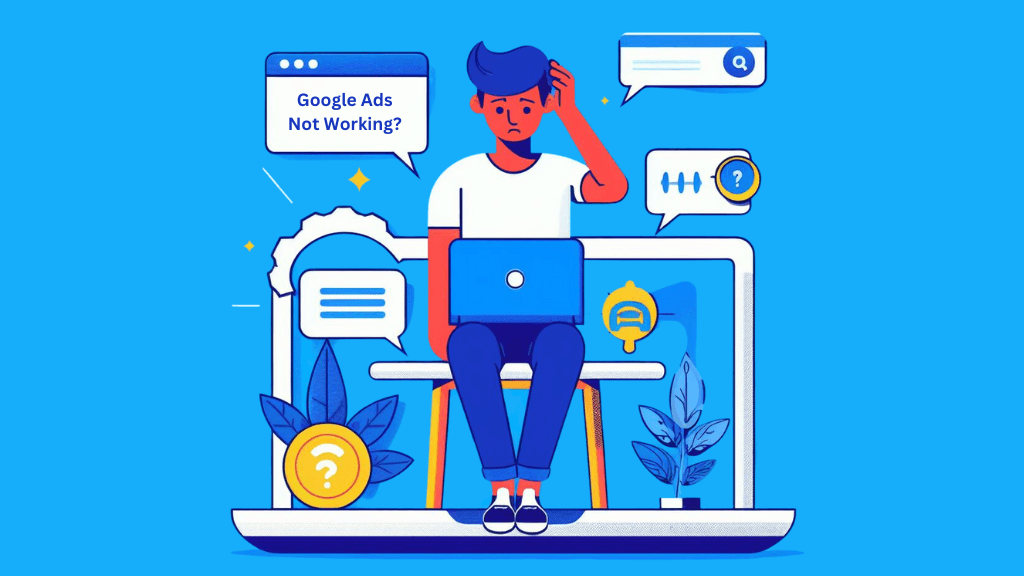If you’ve invested time and money into creating Google Ads campaigns but are struggling to get clicks, you’re not alone. Many advertisers face this challenge. However, it’s essential to understand that there could be several reasons behind your ads not getting the attention they deserve. In this comprehensive guide, we’ll explore the common issues that might be causing low click-through rates (CTR) in your Google Ads campaigns and provide practical solutions to address them.
Table of Contents
Poorly Targeted Keywords
One of the most common reasons for low click-through rates in Google Ads is poorly chosen keywords. Keywords are the foundation of your campaign, and if they don’t align with what users are searching for, your ads won’t get clicked. To fix this issue:
- Keyword Research: Invest time in thorough keyword research using tools like Google Keyword Planner or third-party tools. Look for keywords that are relevant to your products or services and have a reasonable search volume.
- Negative Keywords: Use negative keywords to filter out irrelevant traffic. For example, if you’re selling high-end watches, you may want to exclude terms like “cheap” or “affordable” to avoid attracting budget-conscious shoppers.
- Broad vs. Exact Match: Ensure that you are using the right match types for your keywords. Broad match keywords may lead to clicks from users with different intentions, while exact match keywords can bring in highly targeted traffic.
Poor Ad Copy
Your ad copy plays a pivotal role in enticing users to click on your ads. If your ad copy is dull or irrelevant, users won’t be motivated to click. Here’s how to improve your ad copy:
- Compelling Headlines: Craft attention-grabbing headlines that address the user’s problem or need. Use power words like “exclusive,” “limited time offer,” or “free” to create urgency.
- Clear Value Proposition: Clearly communicate the benefits of your product or service in the ad copy. Explain how it can solve the user’s problem or fulfill their needs.
- Call to Action (CTA): Include a strong CTA that encourages users to take action. Phrases like “Buy Now,” “Learn More,” or “Get Started” can be effective in prompting clicks.
Ineffective Ad Extensions
Ad extensions are additional pieces of information that can appear with your ads. They provide more context to users and can boost your ad’s visibility. If your ad extensions are lacking or misconfigured, it can impact click-through rates. Here’s what you can do:
- Sitelink Extensions: Include sitelink extensions that direct users to specific pages on your website. For example, if you’re running an e-commerce store, you can add sitelinks for categories like “Men’s Clothing” or “Women’s Accessories.”
- Callout Extensions: Use callout extensions to highlight key selling points or offers. Mention benefits like “24/7 Customer Support” or “Free Shipping.”
- Structured Snippets: Utilize structured snippet extensions to provide more details about your products or services. This can help users better understand what you offer.
Landing Page Quality
Even if your ad is enticing, users may not click if the landing page doesn’t meet their expectations. To ensure a seamless user experience and improve click-through rates:
- Relevance: Ensure that your landing page is relevant to the ad. If your ad promises a specific product or service, make sure the landing page delivers on that promise.
- Page Speed: Slow-loading pages can deter users from exploring your website. Optimize your landing page for speed to prevent potential customers from bouncing.
- Mobile Optimization: With the increasing use of mobile devices, it’s crucial to have a mobile-friendly landing page. A responsive design ensures that your page looks and functions well on all screen sizes.
- Clear Call to Action: Make it easy for users to take the desired action on your landing page, whether it’s making a purchase, filling out a form, or signing up for a newsletter.
Ad Position
The position of your ad on the search engine results page (SERP) can significantly impact click-through rates. Ads that appear at the top tend to receive more clicks. To improve your ad position:
- Bid Strategy: Adjust your bidding strategy to aim for a higher position. You may need to increase your bids to compete effectively, especially for competitive keywords.
- Quality Score: Work on improving your Quality Score, as it directly affects ad rank. High-quality ads, relevant keywords, and landing page experience can boost your Quality Score.
Budget Constraints
If your daily budget is too low, your ads may not get enough exposure to generate clicks. Here are some steps to address budget constraints:
- Increase Budget: Consider increasing your daily budget to ensure your ads are shown to a larger audience throughout the day.
- Ad Scheduling: Optimize your ad scheduling to focus your budget on the times of day when your target audience is most active.
Ad Fatigue
Ad fatigue occurs when your audience repeatedly sees the same ad, leading to a decline in engagement. To combat ad fatigue:
- Ad Rotation: Use ad rotation settings to ensure that different ad variations are shown to users. This keeps your ads fresh and engaging.
- Regular Updates: Periodically update your ad creative to maintain user interest. This can include changing visuals, headlines, or offers.
Competition
In highly competitive industries, getting clicks can be challenging. To stand out:
- Differentiate Your Offer: Highlight what makes your product or service unique or superior to competitors.
- Long-Tail Keywords: Target long-tail keywords that are specific to your niche. These keywords may have less competition and can attract more qualified traffic.
Conclusion
Getting clicks on your Google Ads campaigns can be a complex process, but by addressing the issues discussed in this guide, you can significantly improve your click-through rates. Remember that continuous monitoring, testing, and optimization are essential for ongoing success in the world of online advertising. By refining your keyword targeting, optimizing ad copy, and ensuring a seamless user experience, you’ll be well on your way to boosting the performance of your Google Ads campaigns.
